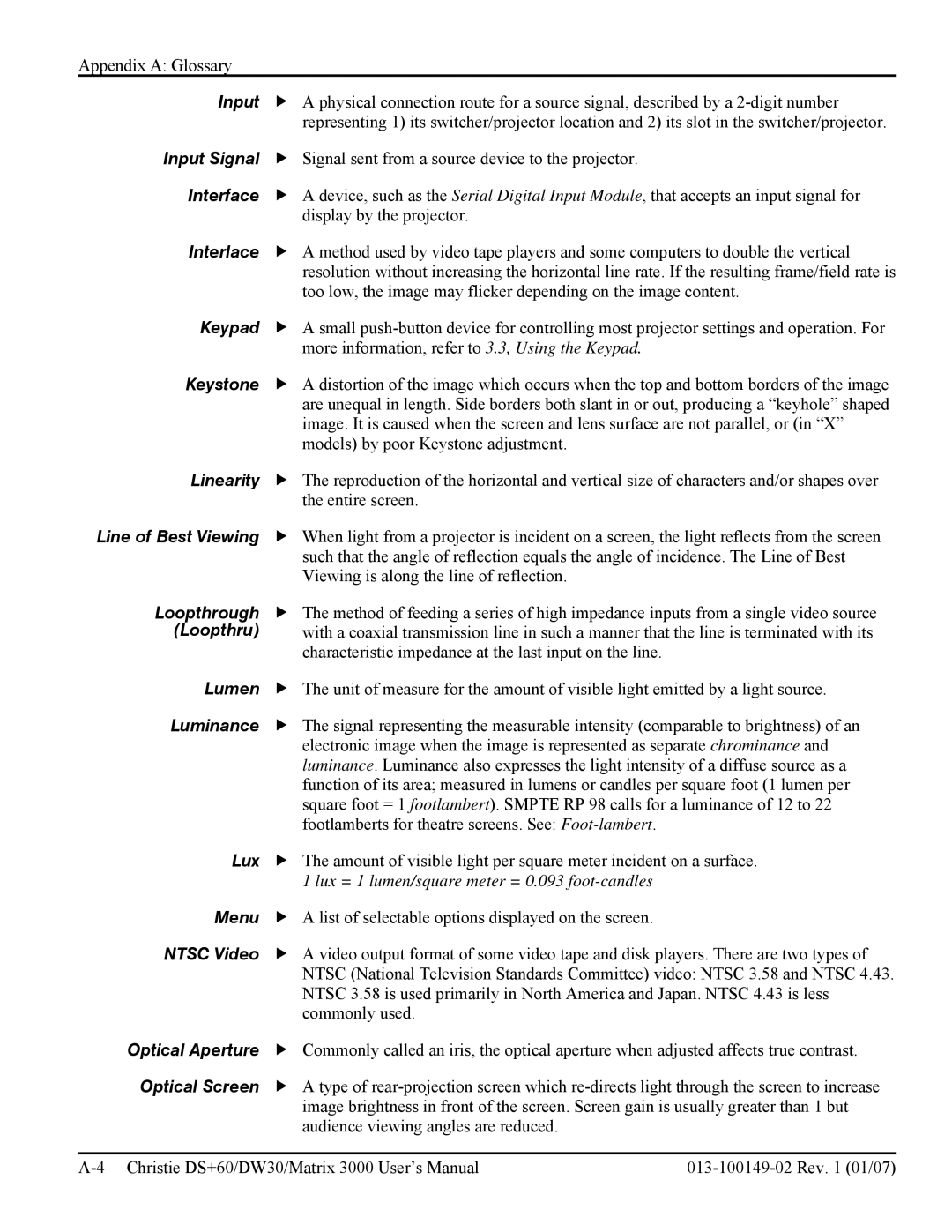
Appendix A: Glossary
Input | f A physical connection route for a source signal, described by a | |
| representing 1) its switcher/projector location and 2) its slot in the switcher/projector. | |
Input Signal | f Signal sent from a source device to the projector. |
|
Interface | f A device, such as the Serial Digital Input Module, that accepts an input signal for | |
| display by the projector. |
|
Interlace | f A method used by video tape players and some computers to double the vertical | |
| resolution without increasing the horizontal line rate. If the resulting frame/field rate is | |
| too low, the image may flicker depending on the image content. | |
Keypad | f A small | |
| more information, refer to 3.3, Using the Keypad. |
|
Keystone | f A distortion of the image which occurs when the top and bottom borders of the image | |
| are unequal in length. Side borders both slant in or out, producing a “keyhole” shaped | |
| image. It is caused when the screen and lens surface are not parallel, or (in “X” | |
| models) by poor Keystone adjustment. |
|
Linearity | f The reproduction of the horizontal and vertical size of characters and/or shapes over | |
| the entire screen. |
|
Line of Best Viewing | f When light from a projector is incident on a screen, the light reflects from the screen | |
| such that the angle of reflection equals the angle of incidence. The Line of Best | |
| Viewing is along the line of reflection. |
|
Loopthrough | f The method of feeding a series of high impedance inputs from a single video source | |
(Loopthru) | with a coaxial transmission line in such a manner that the line is terminated with its | |
| characteristic impedance at the last input on the line. |
|
Lumen | f The unit of measure for the amount of visible light emitted by a light source. | |
Luminance | f The signal representing the measurable intensity (comparable to brightness) of an | |
| electronic image when the image is represented as separate chrominance and | |
| luminance. Luminance also expresses the light intensity of a diffuse source as a | |
| function of its area; measured in lumens or candles per square foot (1 lumen per | |
| square foot = 1 footlambert). SMPTE RP 98 calls for a luminance of 12 to 22 | |
| footlamberts for theatre screens. See: |
|
Lux | f The amount of visible light per square meter incident on a surface. | |
| 1 lux = 1 lumen/square meter = 0.093 |
|
Menu | f A list of selectable options displayed on the screen. |
|
NTSC Video | f A video output format of some video tape and disk players. There are two types of | |
| NTSC (National Television Standards Committee) video: NTSC 3.58 and NTSC 4.43. | |
| NTSC 3.58 is used primarily in North America and Japan. NTSC 4.43 is less | |
| commonly used. |
|
Optical Aperture | f Commonly called an iris, the optical aperture when adjusted affects true contrast. | |
Optical Screen | f A type of | |
| image brightness in front of the screen. Screen gain is usually greater than 1 but | |
| audience viewing angles are reduced. |
|
|
| |
